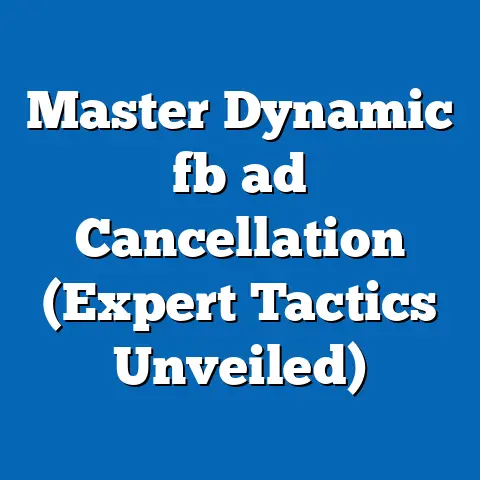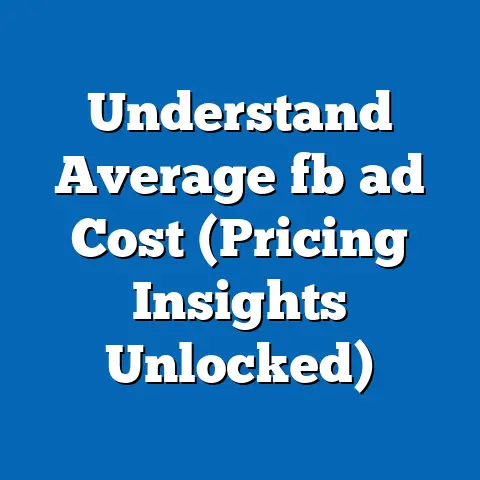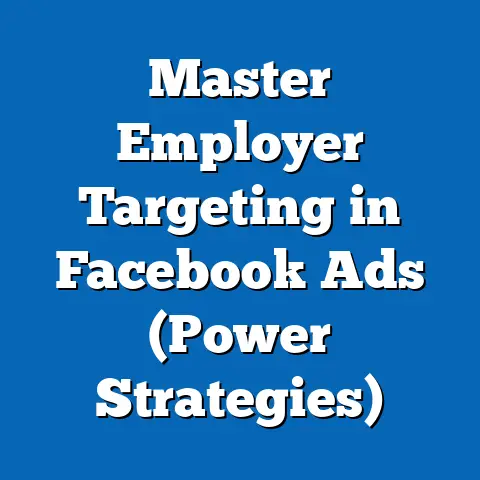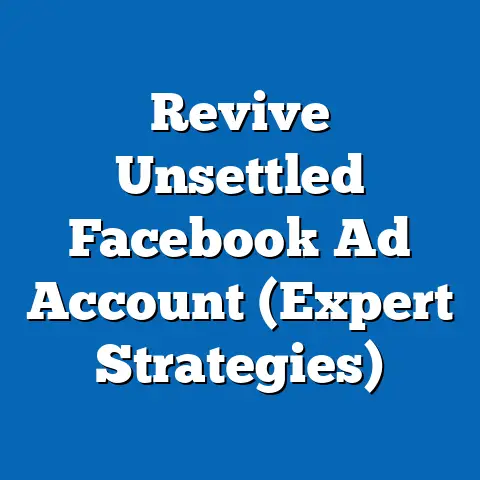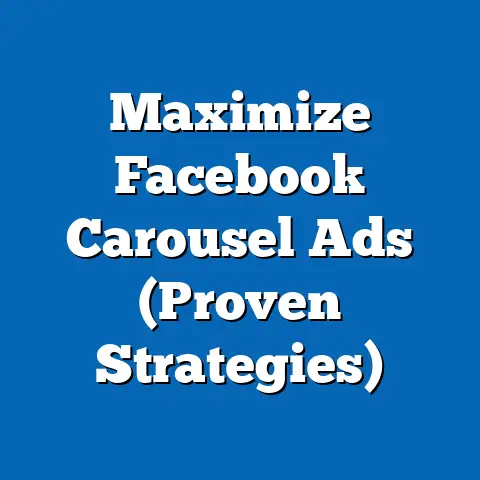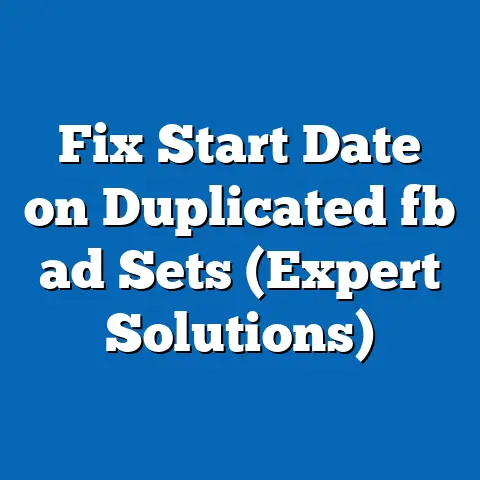Master Facebook Ads Targeting in KM (Unlock Precision Tactics)
The world of digital marketing is in constant flux. What worked yesterday might be obsolete tomorrow. This rapid evolution demands that we, as marketers, become incredibly adaptable, always ready to pivot and refine our strategies. One area where this agility is absolutely crucial is Facebook Ads targeting. It’s not a “set it and forget it” situation; it’s a continuous process of learning, adapting, and optimizing. The beauty of Facebook Ads lies in its flexibility – you can literally change your targeting on the fly, responding to emerging trends, shifting audience behaviors, and, most importantly, your evolving business goals.
Facebook Ads targeting is the bedrock of successful campaigns. Without a laser-sharp focus on the right audience, your message, no matter how brilliant, will fall on deaf ears. Think of it like this: you wouldn’t try to sell snow shovels in Miami, would you? Similarly, you need to ensure your Facebook ads reach the people most likely to be interested in what you have to offer.
1. Understanding Facebook Ads Targeting
So, what exactly is Facebook Ads targeting? Simply put, it’s the process of defining the specific audience you want to see your ads. It’s about narrowing down the vast pool of Facebook users to a more manageable and relevant group. This ensures that your ad dollars are spent efficiently, reaching people who are genuinely interested in your products, services, or information.
Facebook offers a wide array of targeting options, which I’ll break down for you:
-
Demographic Targeting: This is the foundational layer, allowing you to target users based on basic information like age, gender, location, education level, job title, relationship status, and language. For a KM professional, this might mean targeting individuals aged 30-55 who are employed in management roles within a specific industry.
-
Interest-Based Targeting: This option allows you to reach users based on their expressed interests and hobbies. Facebook gathers this information from the pages they like, the content they engage with, and the topics they discuss. For a KM campaign, you might target users interested in topics like “Knowledge Management,” “Information Architecture,” “Collaboration Tools,” or “Organizational Learning.”
-
Behavioral Targeting: This goes beyond interests and looks at users’ actual behaviors on and off Facebook. This includes purchase behaviors, device usage, travel habits, and more. For example, you could target users who have recently purchased online courses related to project management or those who frequently use cloud-based collaboration tools.
-
Custom Audiences: This is where things get really interesting. Custom Audiences allow you to upload your own data (like email lists, website visitors, or app users) and target those specific individuals on Facebook. This is incredibly powerful for retargeting campaigns or for reaching existing customers with tailored messages.
-
Lookalike Audiences: Taking Custom Audiences a step further, Lookalike Audiences allow you to find new people on Facebook who share similar characteristics and interests with your existing customers or website visitors. This is a fantastic way to expand your reach and find potential new clients who are likely to be interested in your KM services.
Demographic Targeting: This is the foundational layer, allowing you to target users based on basic information like age, gender, location, education level, job title, relationship status, and language. For a KM professional, this might mean targeting individuals aged 30-55 who are employed in management roles within a specific industry.
Interest-Based Targeting: This option allows you to reach users based on their expressed interests and hobbies. Facebook gathers this information from the pages they like, the content they engage with, and the topics they discuss. For a KM campaign, you might target users interested in topics like “Knowledge Management,” “Information Architecture,” “Collaboration Tools,” or “Organizational Learning.”
Behavioral Targeting: This goes beyond interests and looks at users’ actual behaviors on and off Facebook. This includes purchase behaviors, device usage, travel habits, and more. For example, you could target users who have recently purchased online courses related to project management or those who frequently use cloud-based collaboration tools.
Custom Audiences: This is where things get really interesting. Custom Audiences allow you to upload your own data (like email lists, website visitors, or app users) and target those specific individuals on Facebook. This is incredibly powerful for retargeting campaigns or for reaching existing customers with tailored messages.
Lookalike Audiences: Taking Custom Audiences a step further, Lookalike Audiences allow you to find new people on Facebook who share similar characteristics and interests with your existing customers or website visitors. This is a fantastic way to expand your reach and find potential new clients who are likely to be interested in your KM services.
The beauty of Facebook Ads is the ease with which you can switch between these targeting strategies. You’re not locked into one approach. You can experiment, test different combinations, and continuously optimize your targeting based on performance data. I’ve personally witnessed campaigns transformed by simply tweaking the audience based on initial results. One time, I was running a campaign for a SaaS product and initially targeted a broad audience interested in “business software.” While the campaign generated some leads, the conversion rate was low. I then narrowed the targeting to focus on users specifically interested in “CRM software” and “project management tools.” The result? A significant increase in lead quality and a much higher conversion rate.
Key Takeaway: Facebook Ads targeting offers a wide range of options, from basic demographics to advanced behavioral and custom audiences. The key is to understand your target audience and leverage the right combination of targeting options to reach them effectively.
2. The Importance of Precision Tactics in KM
Now, let’s talk about why precision targeting is so crucial for Knowledge Management professionals and organizations. In the KM world, it’s not just about broadcasting information to the masses; it’s about connecting the right people with the right knowledge at the right time.
Think about it: a large organization might have thousands of employees, but only a small fraction of them might be directly involved in specific KM initiatives. Reaching those individuals with targeted messages about new knowledge repositories, training programs, or collaboration tools is far more effective than sending a generic email to everyone.
Understanding audience segmentation is paramount. Different groups within an organization will have different knowledge needs and preferences. For example, senior management might be interested in high-level reports and strategic insights, while frontline employees might need practical guidance and troubleshooting tips. Tailoring your messaging and content to each segment ensures that the information is relevant and engaging.
I’ve seen firsthand how KM organizations have successfully used Facebook Ads targeting to reach specific audiences. For instance, a large consulting firm used Facebook Ads to promote a new knowledge-sharing platform specifically designed for their project managers. By targeting project managers with ads highlighting the platform’s benefits (e.g., improved collaboration, reduced project delays), they were able to drive rapid adoption and increase knowledge sharing across the organization.
Another example is a non-profit organization that used Facebook Ads to promote a series of webinars on specific KM topics. By targeting users interested in “knowledge management,” “non-profit management,” and “organizational development,” they were able to attract a highly engaged audience and generate valuable leads for their organization.
The relationship between precise targeting and improved ROI for KM-focused campaigns is undeniable. By focusing your ad spend on the people who are most likely to be interested in your message, you’ll get more bang for your buck. You’ll see higher engagement rates, lower cost per acquisition, and ultimately, a better return on your investment. I once worked with a KM consultancy that was struggling to generate leads through traditional marketing channels. After implementing a targeted Facebook Ads campaign, they saw a dramatic increase in lead generation and a significant improvement in their overall marketing ROI. The key was identifying the specific audience they wanted to reach (e.g., senior executives in large organizations) and crafting compelling ads that spoke directly to their needs and pain points.
Key Takeaway: Precision targeting is essential for KM professionals and organizations. By understanding audience segmentation and tailoring your messaging to specific groups, you can improve engagement, drive adoption, and achieve a better ROI for your KM campaigns.
3. Crafting Your Target Audience
Now that we understand the importance of precision targeting, let’s dive into the practical steps of crafting your ideal target audience within the KM niche. This is where the real work begins!
The first step is identifying and defining your target audience. This involves answering some key questions:
- Who are you trying to reach? (e.g., project managers, senior executives, IT professionals)
- What are their key characteristics? (e.g., age, gender, location, industry, job title)
- What are their interests and needs? (e.g., knowledge management, collaboration tools, information architecture)
- What are their pain points? (e.g., difficulty finding information, lack of knowledge sharing, inefficient workflows)
Once you have a clear understanding of your target audience, you can start using various tools and methods for audience research. Here are a few of my favorites:
-
Facebook Audience Insights: This is a free tool within Facebook Ads Manager that provides valuable insights into the demographics, interests, and behaviors of your target audience. You can use it to explore different audience segments and identify potential targeting options.
-
Surveys and Feedback Forms: Gathering direct feedback from your target audience is invaluable. You can use surveys and feedback forms to ask questions about their knowledge needs, pain points, and preferences. This information can then be used to refine your targeting strategies.
-
Social Media Listening Tools: These tools allow you to monitor social media conversations and identify trends related to your target audience. You can use them to understand the topics they’re discussing, the challenges they’re facing, and the influencers they follow.
Facebook Audience Insights: This is a free tool within Facebook Ads Manager that provides valuable insights into the demographics, interests, and behaviors of your target audience. You can use it to explore different audience segments and identify potential targeting options.
Surveys and Feedback Forms: Gathering direct feedback from your target audience is invaluable. You can use surveys and feedback forms to ask questions about their knowledge needs, pain points, and preferences. This information can then be used to refine your targeting strategies.
Social Media Listening Tools: These tools allow you to monitor social media conversations and identify trends related to your target audience. You can use them to understand the topics they’re discussing, the challenges they’re facing, and the influencers they follow.
The next crucial step is creating buyer personas. A buyer persona is a semi-fictional representation of your ideal customer. It’s based on research and data about your existing customers and potential prospects. A well-developed buyer persona will include information about their demographics, job title, responsibilities, goals, challenges, and motivations.
For example, a buyer persona for a KM campaign might look like this:
- Name: Sarah Jones
- Job Title: Senior Project Manager
- Industry: Construction
- Responsibilities: Managing project teams, ensuring project deadlines are met, controlling project costs
- Goals: Improve project efficiency, reduce project delays, increase team collaboration
- Challenges: Difficulty finding information, lack of knowledge sharing, inefficient workflows
- Motivations: Career advancement, recognition for her contributions, a desire to make a positive impact
Having a clear buyer persona will help you focus your targeting efforts and craft compelling ads that resonate with your target audience. I’ve personally found that creating buyer personas is one of the most effective ways to improve the performance of my Facebook Ads campaigns. It forces you to think deeply about your target audience and understand their needs and pain points.
Case studies can also demonstrate the effectiveness of well-defined target audiences in KM campaigns. For example, a healthcare organization used Facebook Ads to promote a new knowledge portal specifically designed for their nurses. By targeting nurses with ads highlighting the portal’s benefits (e.g., easy access to patient information, clinical guidelines, and best practices), they were able to drive rapid adoption and improve patient care. The key to their success was understanding the specific needs and pain points of their target audience and crafting compelling ads that spoke directly to those needs.
Key Takeaway: Crafting your target audience involves identifying and defining your ideal customer, conducting thorough audience research, and creating detailed buyer personas. This will help you focus your targeting efforts and craft compelling ads that resonate with your target audience.
4. Advanced Targeting Techniques
Now that you have a solid understanding of your target audience, let’s explore some advanced targeting techniques that can help you take your Facebook Ads campaigns to the next level.
-
Layering Multiple Targeting Options: This involves combining different targeting options to create a more precise audience. For example, you could target users who are interested in “knowledge management” and who work in the “healthcare” industry and who are in a “management” role. This allows you to reach a highly specific group of individuals who are likely to be interested in your message.
-
Utilizing Geolocation Targeting: This allows you to target users based on their location. This is particularly useful for local KM initiatives, such as promoting workshops or events in a specific city or region. You can even target users who are within a certain radius of a specific location, such as a conference venue.
-
Retargeting Strategies: Retargeting involves showing ads to people who have previously interacted with your website, app, or Facebook page. This is a highly effective way to re-engage past visitors or users and encourage them to take action. For example, you could retarget users who visited your website but didn’t fill out a contact form, or users who abandoned their shopping cart on your e-commerce store.
-
A/B Testing: A/B testing involves creating multiple versions of your ads and testing them against each other to see which one performs best. This can be used to test different targeting options, ad copy, images, and calls to action. By continuously A/B testing your ads, you can refine your targeting parameters and improve your ad effectiveness.
Layering Multiple Targeting Options: This involves combining different targeting options to create a more precise audience. For example, you could target users who are interested in “knowledge management” and who work in the “healthcare” industry and who are in a “management” role. This allows you to reach a highly specific group of individuals who are likely to be interested in your message.
Utilizing Geolocation Targeting: This allows you to target users based on their location. This is particularly useful for local KM initiatives, such as promoting workshops or events in a specific city or region. You can even target users who are within a certain radius of a specific location, such as a conference venue.
Retargeting Strategies: Retargeting involves showing ads to people who have previously interacted with your website, app, or Facebook page. This is a highly effective way to re-engage past visitors or users and encourage them to take action. For example, you could retarget users who visited your website but didn’t fill out a contact form, or users who abandoned their shopping cart on your e-commerce store.
A/B Testing: A/B testing involves creating multiple versions of your ads and testing them against each other to see which one performs best. This can be used to test different targeting options, ad copy, images, and calls to action. By continuously A/B testing your ads, you can refine your targeting parameters and improve your ad effectiveness.
I’ve found that A/B testing is an indispensable tool for optimizing Facebook Ads campaigns. I always recommend testing different targeting options, ad creatives, and calls to action to see what resonates best with your target audience. For example, I once ran a campaign for a KM software company and tested two different targeting options: one targeting users interested in “knowledge management” and another targeting users interested in “collaboration tools.” I found that the “collaboration tools” targeting option performed significantly better, generating more leads at a lower cost. This insight allowed me to focus my ad spend on the more effective targeting option and improve the overall performance of the campaign.
Actionable insights on how to analyze ad performance data to further refine targeting strategies are crucial. Facebook Ads Manager provides a wealth of data about your ad performance, including impressions, clicks, reach, engagement, and conversions. By analyzing this data, you can identify which targeting options are performing well and which ones are not. You can then use this information to refine your targeting strategies and improve your ad effectiveness. For example, if you see that a particular targeting option is generating a lot of impressions but few clicks, it might indicate that your ad copy or creative is not resonating with that audience. You can then experiment with different ad copy or creatives to see if you can improve the click-through rate.
Key Takeaway: Advanced targeting techniques can significantly enhance your ad performance. Layering targeting options, utilizing geolocation targeting, implementing retargeting strategies, and A/B testing your ads are all powerful tools that can help you reach your target audience more effectively.
5. Measuring Success and Adapting Strategies
No marketing campaign is complete without a way to measure its success. For Facebook Ads targeting in the KM space, there are several key performance indicators (KPIs) that you should be tracking.
- Reach: The number of unique people who saw your ad.
- Impressions: The number of times your ad was displayed.
- Click-Through Rate (CTR): The percentage of people who saw your ad and clicked on it.
- Engagement: The number of likes, comments, shares, and other interactions your ad received.
- Conversions: The number of people who took a desired action after seeing your ad (e.g., filling out a contact form, downloading a whitepaper, registering for a webinar).
- Cost Per Acquisition (CPA): The cost of acquiring one customer or lead through your Facebook Ads campaign.
- Return on Ad Spend (ROAS): The revenue generated for every dollar spent on your Facebook Ads campaign.
Interpreting analytics to assess the effectiveness of targeting tactics is essential. Are you reaching the right people? Are they engaging with your ads? Are they taking the desired actions? By analyzing your ad performance data, you can identify areas where your targeting strategies are working well and areas where they need improvement.
The importance of continuous learning and adjustment in targeting strategies based on data insights cannot be overstated. Facebook Ads targeting is not a “set it and forget it” process. You need to continuously monitor your ad performance, analyze your data, and adjust your targeting strategies based on what you learn. This is an ongoing process of experimentation, optimization, and improvement.
Key Takeaway: Measuring success and adapting strategies is crucial for optimizing your Facebook Ads campaigns. Track your KPIs, interpret your analytics, and continuously adjust your targeting strategies based on data insights.
Conclusion
Mastering Facebook Ads targeting is an ongoing journey, not a destination. It requires a willingness to experiment, learn, and adapt. By understanding the different targeting options available, crafting your ideal target audience, and continuously monitoring your ad performance, you can unlock the full potential of Facebook Ads and achieve your KM goals.
I encourage you to take action and implement the precision tactics discussed in this guide. Start by defining your target audience, creating buyer personas, and experimenting with different targeting options. Don’t be afraid to fail, and don’t be afraid to adjust your strategies based on what you learn. The potential for improved marketing outcomes in your KM initiatives is enormous.
Remember, the key to success with Facebook Ads targeting is to be flexible, responsive, and data-driven. The platform is constantly evolving, so it’s important to stay up-to-date with the latest features and best practices. By embracing a mindset of continuous learning and improvement, you can master Facebook Ads targeting and achieve your KM goals.
Call to Action:
I’d love to hear about your experiences with Facebook Ads targeting. Share your thoughts, questions, and insights in the comments section below. Let’s learn from each other and build a community of knowledge sharing. You can also connect with me on social media to continue the conversation. Together, we can unlock the power of precision targeting and achieve our KM goals.

